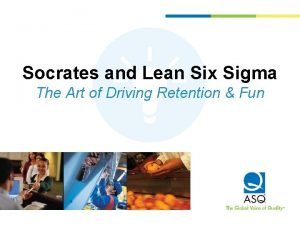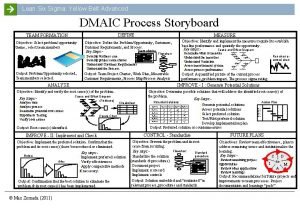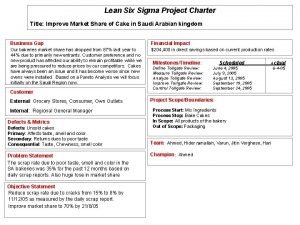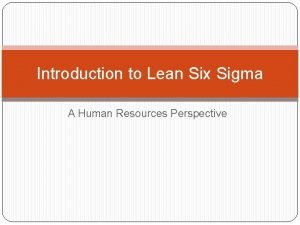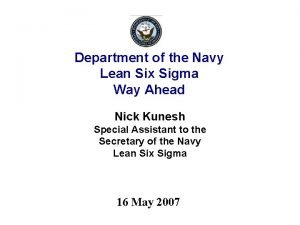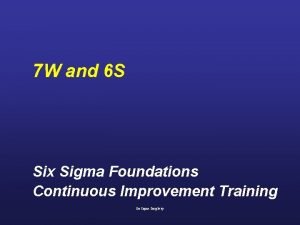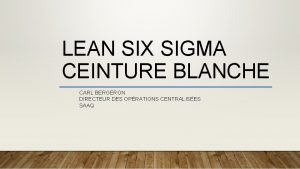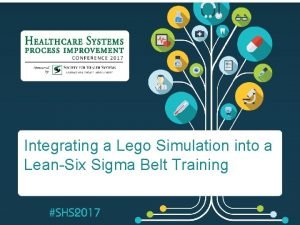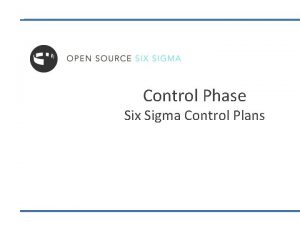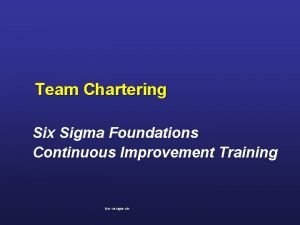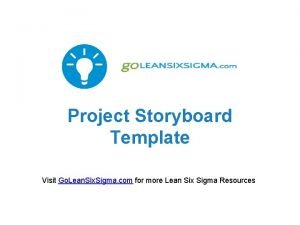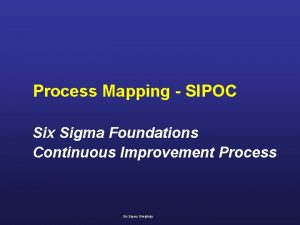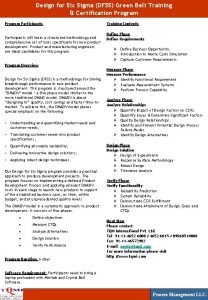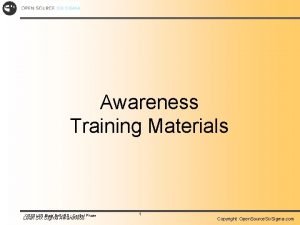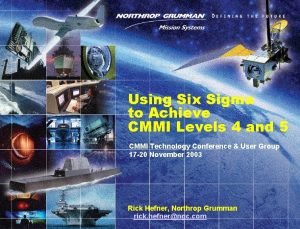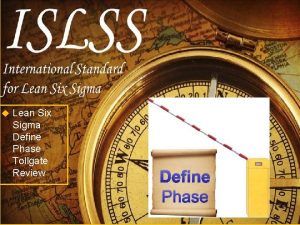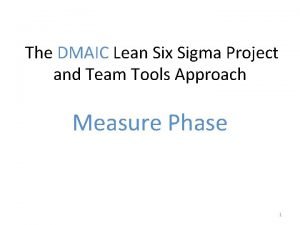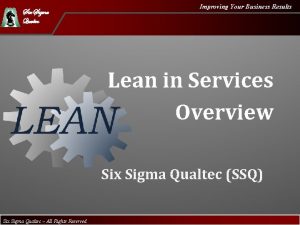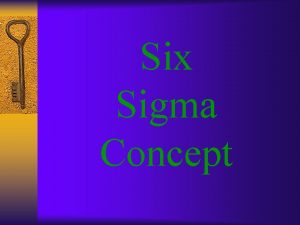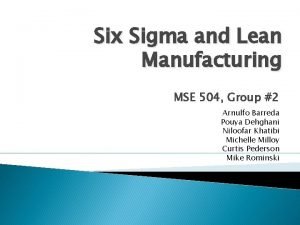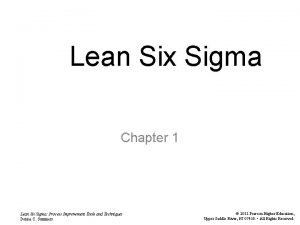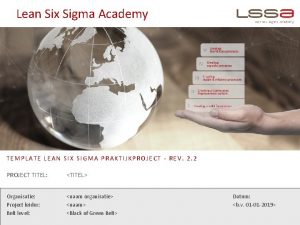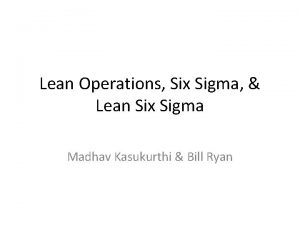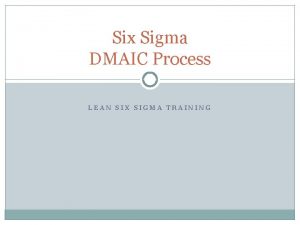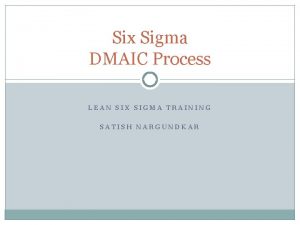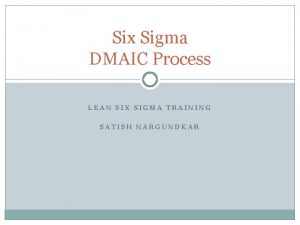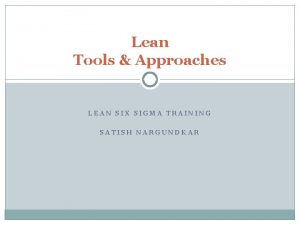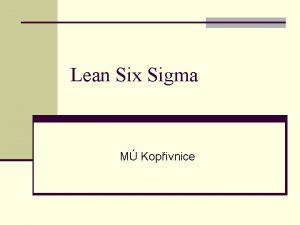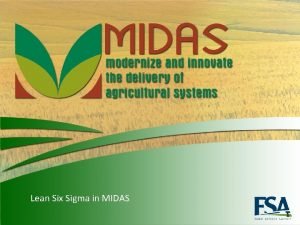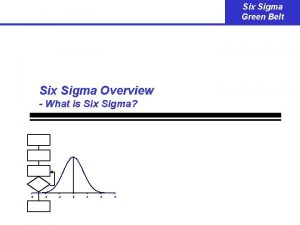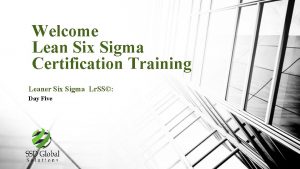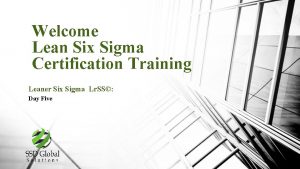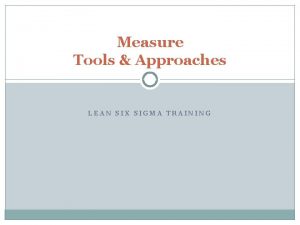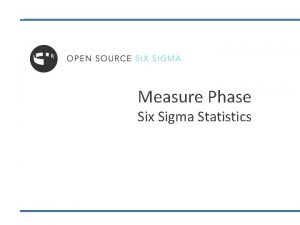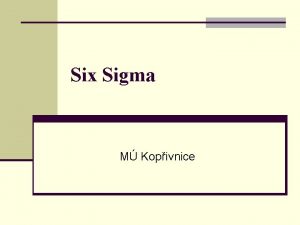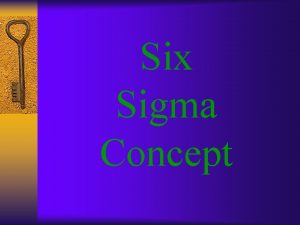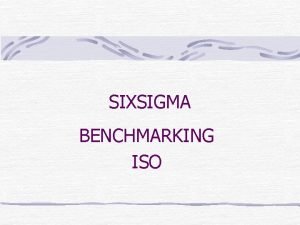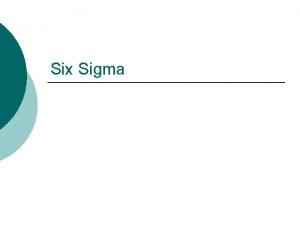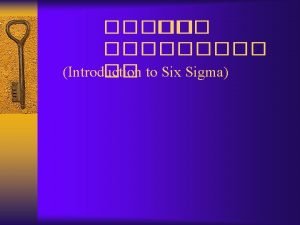Lean Overview Approaches LEAN SIX SIGMA TRAINING What

























- Slides: 25

Lean Overview & Approaches LEAN SIX SIGMA TRAINING

What is Lean? Lean: Set of practices or Set of tools and techniques to reduce “waste” and non-value added activities in organizational processes.

Why Lean Matters: A visual example �Toyota helps Hurricane Sandy victims video What’s is the featured process? What process outcomes are improved? What process improvement principles are demonstrated? Which process characteristics resonate with your own project? (Source: Toyota. Katrina)

Key Lean Principles 1. 2. 3. 4. 5. Define customer value Map the value stream Enable flow Develop pull Improve continuously Source: Design 4 Lean. com

1. Define customer value �Remembering Toyota/Hurricane Sandy: �Who is the customer? External Next step in the process �What does the customer need? When (rate of speed and timing) How much Quality

2. Map the value stream �What is a value stream map (VSM)? Material flow + Information flow Supplier to customer Customer to supplier

Value Stream Mapping (VSM) Goal: To understand what is actually happening in the process. To help see problems clearly. Drawing the VSM 1. Show process steps 2. Note time taken for each step (Value Added Time) 3. Note time between steps (Non Value Added Time) 4. Sum both for the entire process 5. Compute efficiency GEMBA: Walk the process! Take samples, note variations too. Ron Pereira, GEMBA Academy Blog

2. Map the value stream (icons) Process Step Order entry Inventory location Information Other Flow Major Functions Planning I Metrics Takt = Cycle Time = Lead Time = WIP = Transportation Electronic Information Flow Push

2. Map the value stream (example) Source: https: VSMMotorcyles

3. Map the value stream (practice) High level delivery path (flowchart or process map) from customer request to delivery of product or service – includes materials, people, information

3. Map the value stream (practice) Unbalanced Process: Capacity is limited by the slowest step (smallest output in time period!) Units per month Stage 1 8, 000 Stage 2 7, 000 Stage 3 6, 000 Balanced Process: The output of one stage is the exact input requirement for the next stage! Stage 1 Units 7, 000 per month Stage 2 7, 000 Stage 3 7, 000

2. Map the value stream (cont. ) Analyze the value stream �Value adding �Non-value adding �Value enabling (Non value added but required).

Waste (“Muda”) Elimination 7 Types of Waste – TIM WOOD � T ransportation � I nventory � M ovement � W aiting � O verproduction � O ver-processing � D efects Spaghetti Diagram (Source: http: //leanprogression. co. uk/lean-techniques/spaghetti-diagram) Youtube Video

3. Enable (Smooth) Flow: Takt Time, Cycle Time, Throughput Time Takt Time. German “Takt” means Beat, as in the timing of music. It sets the rate at which the process should operate based on customer demand. Takt Time = Time Available/Customer Demand

3. Enable (Smooth) Flow: Takt Time, Cycle Time, Throughput Time Takt Time. Takt time = Available time / Customer demand Example Total Time: 8 Hours X 60 Minutes = 480 Minutes Breaks: 50 Minutes Time Available : 430 Minutes Customer Demand in 8 Hours: 100 Pcs Takt Time: 430 / 100 = 4. 3 Minutes = 258 Seconds

3. Enable (Smooth) Flow: Takt Time, Cycle Time, Throughput Time �Lead Time: Time from customer request until he or she is served with the required product or service. �Throughput Time: Time for one part to move through system. The time starts from the moment the organization begins working on a request until the product or service is shipped to the customer. Mc. Donalds Lego video: Mc. Donalds. Takt https: //www. youtube. com/watch? v=7 s. T 14 cxr 02 Six Sigma Academy Amsterdam Video

3. Enable (Smooth) Flow: Standard work, Poka-Yoke, 5 S Cycle Time interval between finished goods (between one piece exiting the system and the next) Cycle time also can refer to the time taken to complete each step in the process. Harvard Business School Operations Toolkit

Poka-Yoke or Error Proofing Photo credit: Chris Burnham, LSS Project Leader

Poka-Yoke The use of process or design features to prevent human errors or their negative impact rather than rely on operators catching mistakes. Poka Yoke: Japanese for “mistake-proofing” or “avoiding inadvertent errors”. TPS (Lean) approaches to prevent mistakes from being made, or make them obvious at a glance. Inexpensive Very effective Based on simplicity and ingenuity Vs.

Poka-Yoke - Detection Stops the process or signals a warning when a defect or irregularity is detected keeps the suspect work in place when a process step is incomplete High capability of achieving error free results

Poka Yoke Prevention examples Prevents defects at the source Zero defect occurrence Gas connections in an Emergency Room at the hospital. Notice the unique pin configuration

5. Improve continuously (5 S) Seiri (Sort) • Discard unnecessary materials “When in doubt, throw it out. ” Seiton (Straighten) • Organize work area • Draw current state map; Seiso (Shine) • Clean the work area daily Establish procedures • “A place for everything, “The best and everything cleaning is not to need any in its place. ” cleaning’ Seiketsu Shitsuke (Standardize) (Sustain) • Implement best practices • Empower employees Make workplace “talk to us” • Monitor performance “The less selfdiscipline you need, the better” Benefits of the 5 S Philosophy: Can you think of a few?

Where do you start? �Start where you are VSM vs. Kaizen �Id the process �Walk the process (go to the Gemba) �A 3

Kaizen � One week process to implement Lean Source: http: //jipsportsbj. info/kaizen-presentation-format-0714 -kaizenevent-process-powerpoint-presentation-slide-template-download/

A 3 �Problem solving �Reporting project status �Proposing policy changes (rules agreed upon and enforced by the group
 Who is this
Who is this Six sigma forum
Six sigma forum Yellow belt dmaic
Yellow belt dmaic Charter lean six sigma
Charter lean six sigma Organizational factors
Organizational factors Navy lean six sigma
Navy lean six sigma Lean six sigma nedir
Lean six sigma nedir 6 s sigma
6 s sigma Ceintures six sigma
Ceintures six sigma Iso 18404 training
Iso 18404 training Control plan six sigma
Control plan six sigma Lean six sigma foundations
Lean six sigma foundations Lean six sigma storyboard
Lean six sigma storyboard Lean six sigma foundations download
Lean six sigma foundations download Dfss green belt certification
Dfss green belt certification Open source six sigma training material
Open source six sigma training material Sigma sigma phi vcom
Sigma sigma phi vcom Vcom auburn white coat ceremony
Vcom auburn white coat ceremony Sigma lean sgrho
Sigma lean sgrho Cmmi six sigma
Cmmi six sigma Microsoft six sigma
Microsoft six sigma Tollgate lean
Tollgate lean Statapult exercise
Statapult exercise Six sigma qualtec
Six sigma qualtec Six sigma kpov
Six sigma kpov Mse six sigma
Mse six sigma
